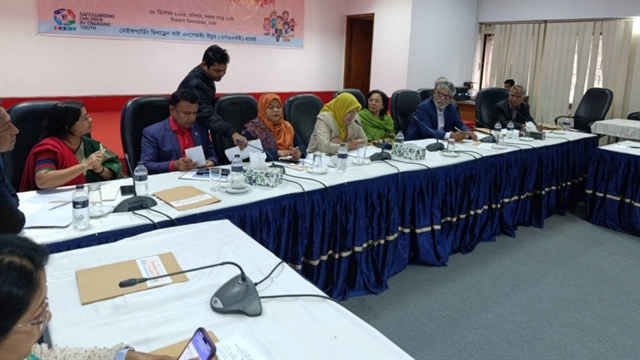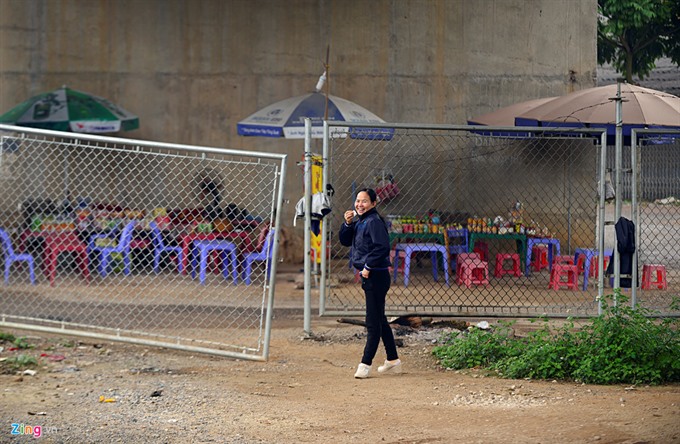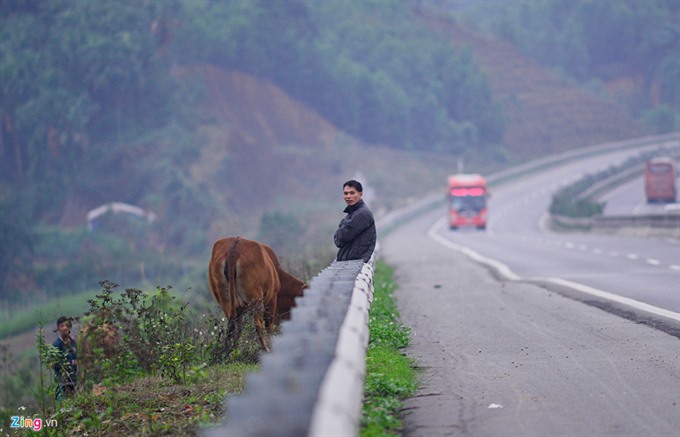 Society
Society

Expressways constructed at a cost of several trillions of đồng have become staging grounds for serious safety violations, mainly due to drivers’ and local people’s ignorance of the roads’ design and signage, Thanh Niên (Young People) newspaper reported.
 |
| Locals run business along the Hà Nội-Lào Cai Expressway. — Photo news.zing.vn |
HÀ NỘI — Expressways constructed at a cost of several trillions of đồng have become staging grounds for serious safety violations, mainly due to drivers’ and local people’s ignorance of the roads’ design and signage, Thanh Niên (Young People) newspaper reported.
On April 3, a woman drove her car in the wrong direction on the Hà Nội-Hải Phòng Expressway. She confessed to the police that she was “too panicked after realising that she had taken the wrong way and could not find the way out on the expressway”.
By the end of February, another woman was fined VNĐ7.5 million and had her driving license revoked for five months because she, too, had been driving in the wrong direction on the Hà Nội-Hải Phòng Expressway.
In the first three months of this year alone, cameras on the HCM City-Long Thành-Dầu Giây Highway recorded six cars driving in the opposite direction nd dozens of cars parking in the wrong places or moving backwards.
Đỗ Văn Thuần, director of Hà Nội-Hải Phòng Expressway managing and operating company, said that drivers lack understanding about traffic signs placed at crossroads.
“Drivers’ awareness remains low as well. In most of the violations, drivers take risks and behave like they are on the village road, not on the expressway,” he said.
Straw burning in the outskirts of many cities has posed risks to highway safety as well.
On April 3, four vehicles crashed in a row on a section of the HCM City-Long Thành-Dầu Giây Expressway running through Đồng Nai Province, injuring four and damaging ten vehicles. The drivers all said that their vision was blocked due to smoke from local people living along the expressway burning straw.
Nguyễn Thị Hoài Phương, deputy director of Việt Nam Expressway Services Engineering Joint Stock Company, said that 16 monitoring cameras installed on the expressway cannot cover every corner to issue warnings. In this case, the smoke could only be seen on the camera until it rose so high that it was already a problem. When the patrol force reached the scene, it was too late.
“Straw burning in the fields is an agricultural tradition of farmers in many areas. The company is unable to ban or ask local authorities to ban this activity,” she said.
What it can do is to collaborate with authorities of provinces and cities through which the expressway runs to clean up areas along the expressway and issue smoke warnings.
Many drivers do not maintain a safe distance between vehicles in conditions of limited vision such as smoke, fog, rain, Phương said.
Disappearance of safety barriers
Local people living along expressways often destroy safety barriers and sell them for scrap. Authorities say barriers’ bolts were removed at nearly 100 spots along the HCM City-Trung Lương Expressway.
Around flyovers crossing Vàm Cỏ Đông and Vàm Cỏ Tây rivers, locals even build animal cages and use the land for collecting scrap. Buffalos are released to roam free along the expressway.
According to Department of Road and Railway Traffic Police, a 19km-long stretch of Nội Bài-Lào Cai Expressway, the longest one in Việt Nam, has hundreds of spots without safety barriers. Locals remove the safety barriers to open space for motorbikes to enter the expressway or for people to walk on the expressway in order to catch coaches.
On the expressway’s sections through Yên Bái and Lào Cai provinces, the barriers were removed by locals again just one night after authorised forces re-erected them.
A representative of the unit in charge of operating Nội Bài-Lào Cai Expressway told Thanh Niên newspaper that local authorities are responsible for holding accountable locals who damage the highway’s safety barriers. The highway’s management agency is not authorized to punish violating people.
Trần Ngọc Sơn, chief of the Secretariat of Traffic Safety Committee of Lào Cai Province said that besides locals’ low awareness of safety hazards, the destruction is due to shortage of designated entry roads, so locals have to remove safety barriers to enter the expressway at a convenient location—or else walk for long stretches.
“We have proposed punishments on violating individuals, however, nothing has been done,” he said.
Transport expert Phạm Sanh said, “Responsibilities for managing the expressways and imposing punishments on violators must be clarified.”
“The expressway system will be expanded. It is highly risky on the expressway if people behave as they do on the village road,” she said.
 |
| Animals run freely along the Hà Nội-Lào Cai Expressway. - Photo news.zing.vn |
Expressway’s regulations need to be tightened
There are currently some 816 km of expressways in operation nationwide, besides 513km of expressways under construction and some 654km of the North-South Expressway in the east approved by the National Assembly and due to be completed by 2021.
In the next few years, more than 2,000 km of expressways will operate across the country.
Expressways will become an extremely important system to replace highways. Expressway safety is of significant importance because managing and operating expressways is different from highways, which are provincial roads, said Nguyễn Quốc Tùng, head of the Expressway Management Department under Transport Ministry.
Tùng proposed that the Road Traffic Law enacted in 2008 must be amended. When the law was enforced, there were no sections of expressway in Việt Nam. Therefore, the law does not detail any expressway regulations.
Expressway regulations must be added when the law is adjusted in 2019 including information on expressway standards, intelligent transport system and drivers’ awareness, he said.
Questions on expressway regulations and traffic signs should be included in the driving test, he said.
According to a decree that took effect in 2010, the safe distance between an expressway and community land is 47 metres. However, in Việt Nam, many expressways do not meet this standard because the majority of expressways run through farming areas.
Traffic experts proposed widening the distance so that people can no longer encroach on land to run businesses along expressways. They also said that barriers made from steel nets must be replaced by firm barriers to prevent destruction. — VNS




